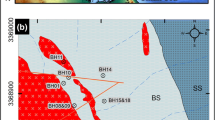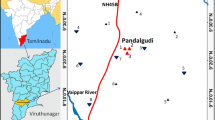Abstract
A multivariate statistical analysis was carried out with log-transformed values of Cu, Ni, Co, Pb, Zn, Ag, Cr, Mn, Ca, and Sr in several sets of samples collected across the mineralized base metal zone in sheared soda granite, feldspathic schist, and chlorite schist from the central section of Mosaboni Mine of the famous Singhbhum Copper Belt of eastern India. Linear correlation coefficient matrices of two sets of ore samples (>0.5% Cu)—one from levels 18 and 21 and the other from levels 25 and 28—indicate two well-defined and distinct clusters comprising Cu, Ni, Co, Pb, and Zn on one hand and Ca, Sr, and Mn on the other. Varimax-rotatedR-mode factor analysis of two above-noted sample sets, taken along with available geologic information, indicates that over 80% of the variability in data matrices for 9–10 elements can be accounted for by four distinct processes: (a) an early phase of copper mineralization which apparently replaced Mn, Ca, and Sr in the host rock; (b) a silicate-cum-oxide phase of crystallization/recrystallization of host rock; (c) remobilization of sulfide-forming ore elements (Cu, Ni, Co, Pb, and Zn); and (d) a phase of mineralization of Ag which appears to have replaced Cr, Ca and Cu. Process (c) was quantitatively most important. Factor score studies are suggestive of preferred introduction of Ni, Co, Pb, and Zn along central parts of preexisting copper-mineralized zones.
Similar content being viewed by others
References
Banerji, A. K., 1962, Cross folding, migmatisation and ore localisation along part of the Singhbhum shear zone, south of Tatanager, Bihar, India: Econ. Geol. v. 57, p. 50–71.
Banerji, A. K., 1974, On the stratigraphy and tectonic history of the Iron Ore bearing and associated rocks of Singhbhum and adjoining areas of Bihar and Orissa: J. Geol. Soc. India, v. 15, no. 2, p. 150–157.
Boyle, R. W., 1974, Elemental association in mineral deposits and indicator elements of interest in geochemical prospecting: Geol. Surv. Canada, paper 74–75, 39 p.
Davis, J. C., 1973, Statistics and data analysis in geology: John Wiley & Sons, New York, 550 p.
Dunn, J. A., 1937, The mineral deposits of Eastern Singhbhum and surrounding areas: Geol. Surv. India: Mem. 69 Pt. 1, p. 1–183.
Ghosh, A. K., 1972, Trace element geochemistry and genesis of the copper ore deposits of the Singhbhum shear zone, Eastern India: Miner. Deposita (Berl), v. 7, p. 292–313.
Harman, H. H., 1967, Modern factor analysis (2nd ed): University of Chicago Press, Chicago.
Hawkes, H. E. and Webb, J. S., 1962, Geochemistry in mineral exploration: Harper & Row, New York, 415 p.
Roy, A., 1981, Application of cluster analysis in the interpretation of geochemical data from the Sargipalli lead-zinc mine area, Sundergarh District; Orissa (India): J. Geochem. Explor., v. 14, p. 245–264.
Roy, A., 1984, A computer-based factor model to elucidate secondary trace-element distribution patterns around the Sargipalli lead-zinc sulphide deposit, Sundergarh District, Orissa (India): J. Geol. Soc. India, v. 25, no. 6, p. 338–348.
Seha, A. K., Lakshmipathy, S., Sankaran, A. V., and Bhattacharya, T. K., 1973, A statistical study of the trace element distribution in the magmatic members of Singhbhum granite: Proc. Ind. Natl. Sci. Acad., v. 39, no. 3, p. 71–84.
Sarkar, S. C., Deb, M., and Roy Chowdhury, K., 1971, Dhanjori basalts and some related rocks: Quart. J. Geol. Min. Met. Soc., India, v. 43, no. 1, p. 29–37.
Sarkar, S. C. and Deb. M., 1974, Metamorphism of sulfides of the Singhbhum Copper Belt, India—The evidence from ore fabric: Econ. Geol., v. 69, p. 1282–1293.
Sarkar, S. N. and Saha, A. K., 1983, Structure and tectonics of the Singhbhum-Orissa Iron Ore Craton, Eastern India,in Recent Researches in Geology, v. 10: Hindustan Publishing Corporation, Delhi, p. 1–25.
Sen Gupta, P. R., 1972, Studies in mineralisation in the south-Eastern part of the Singhbhum Copper Belt, Bihar: Mem. Geol. Surv. India, v. 101, p. 1–82.
Talapatra, A. K., 1982, Application of computer based statistical analysis with the traceelement data from Singhbhum Shear Zone, Bihar: Spec. Pub. Geol. Surv. India, no. 8, Sect. VI, p. 209–221.
Author information
Authors and Affiliations
Rights and permissions
About this article
Cite this article
Saha, A.K., Sarkar, S.N., Basu, S. et al. A multivariate statistical study of copper mineralization in the central section of Mosaboni Mine, Eastern Singhbhum, India. Math Geol 18, 215–235 (1986). https://doi.org/10.1007/BF00898284
Received:
Accepted:
Issue Date:
DOI: https://doi.org/10.1007/BF00898284




